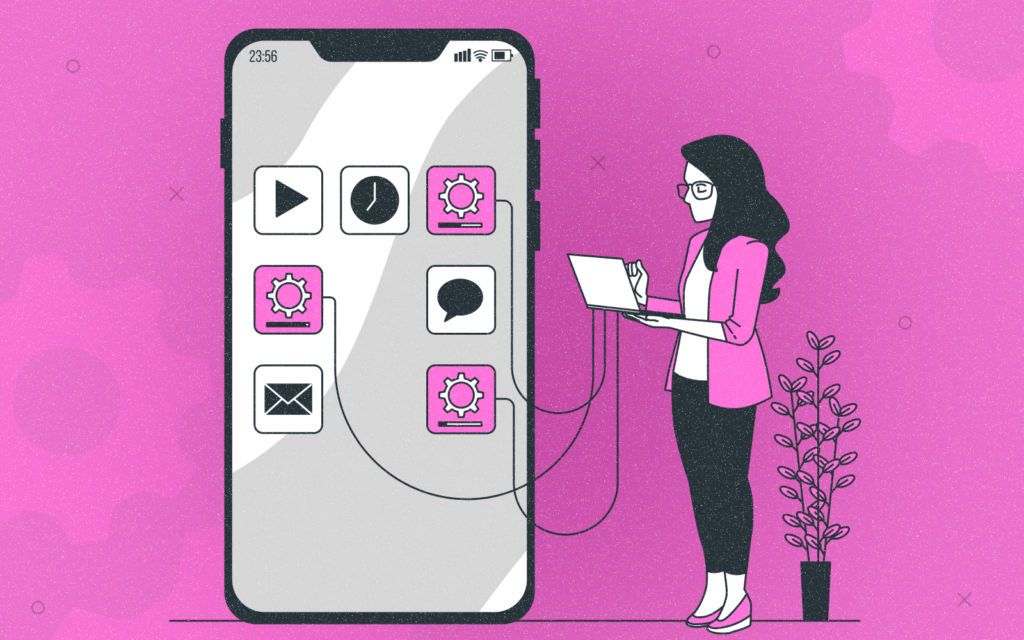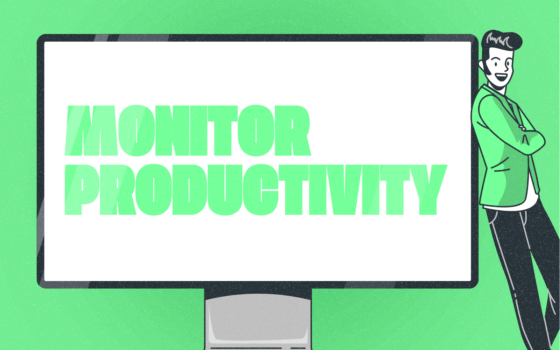Remote Employee Productivity Monitoring Software: Everything You Need to Know


As the world increasingly embraces remote work, it becomes crucial for managers to have time-tracking tools to keep track of their teams’ progress and productivity.
Managing remote employees using employee remote monitoring software can be challenging, as you can’t physically monitor their activities.
Fortunately, various tools now help managers keep track of remote employee activities and improve their performance.
In this post, we’ll discuss what remote employee monitoring software is, its benefits, and tips for selecting the right one for your organization.
What is employee remote monitoring software?
“Distracted workers cost your business time and money because of their low productivity.” Poppy Masselos.
Remote employee monitoring software is a technology tool that enables employers and managers to monitor their remote employees. The software tracks employees’ activities, such as emails, instant messages made and received, websites visited, time spent on tasks, and keystrokes.
The ability to monitor the performance of a company’s remote workforce allows businesses to track team productivity and ensure that work meets specified expectations, including adherence to company guidelines.
How Does Remote Employee Monitoring Software Work?

Remote employee monitoring software enables employers to track employees’ work on their computers, phone, or tablet. The software can run in the background of the employee’s device, collecting data on their activities.
The collected data is then analyzed and reported to employers, providing them with data and insights on their employee’s productivity and performance levels.
Key Features and Benefits of Remote Employee Monitoring Software
Employee monitoring software tools offer the following features and benefits:
Time Tracking
Employee monitoring systems offer a time tracking tool, which allows managers to track the hours worked by remote employees. This feature enables managers to ensure that their remote employees have completed their daily work hours and that their productivity levels are consistent.
Screen Recording
Some remote employee monitoring software enables screen recording of employee time, permitting managers to track employee activity of remote employees. The ability to gain real-time insights into their work activities allows them to identify behaviors they can improve.
Activity Levels
Employee monitoring software tools provide insights into the different activities performed by remote employees across different technological devices. This feature lets managers identify areas where employees struggle and require assistance or enhancements to work more efficiently.
Benefits of Remote Employee Productivity Monitoring Software

Some of the benefits of employee monitoring tracking tools include:
- Increased Productivity– The software facilitates accountability by ensuring remote employees stay on task and work efficiently.
- Improved Performance Insight– The software offers real-time data companies can use to make data-driven decisions about enhancing their remote employees’ productivity.
- Better Communication– The software allows managers to utilize data to intervene if remote employees need support or guidance.
- Keeping Your Team Focused – By examining data on task completion efficiency.
- Improved Communication – Employers can effectively manage workplace issues, such as providing support and guidance, with minimal disruption through these tools.
- Uncover Potential Issues Before They Arise – By utilizing these tools, you can quickly detect patterns that could lead to cyber security breaches or other risks associated with improper handling of confidential information due to miscalculation.
- Improved Collaboration Among Remote Teams – One key benefit often overlooked when discussing employee monitoring is improved collaboration. By providing real-time visibility into who is doing what, it becomes easier for groups within organizations to collaborate more effectively.
- Save Money – With increased efficiency comes cost savings. By using these systems, organizations can save money through reduced labor costs.
- Clarify Expectations & Encourage Professionalism – With clear visibility into how long projects take to complete (and why), expectations are easier to manage amongst all parties involved.
The Ethical Concerns of Software to Monitor Remote Employees

While remote employee monitoring software is helpful for businesses, it has some ethical concerns.
One primary concern is employees’ privacy, as monitoring their activities may be perceived as intrusive. Additionally, technology has become necessary for managing employees’ activities, but it is causing distrust among busy managers tracking employees.
Employers should establish clear guidelines that provide transparent rules about who and when monitoring sensitive data is done, the purpose of the monitoring, and how employee privacy can be improved when using the tools.
It’s also essential to involve employees when setting up the system to receive feedback on their concerns.
Significance and Benefits of Employee Remote Monitoring Software
The goal of employing remote employee tracking software is to improve the productivity and efficiency of remote workers. These employee monitoring solutions work differently from traditional monitoring tools. It lets managers track the activities of remote employees and measure their productivity levels.
With the pandemic leading to the rise of remote work, remote employee monitoring and task management software have become critical. It ensures that remote employees remain on track even when working from home.
Challenges of Managing Remote Employees

Managing remote employees can be challenging, as managers can’t physically monitor their activities. Some of the common challenges include:
- Lack of Trust– Managers might find it challenging to trust their employees. Companies need to ensure employees work productively without supervision.
- Lack of Communication – Managers can miss out on important news and updates due to the lack of regular, face-to-face communication.
- Lack of Structure– Remote employees might need a fixed routine to work productively, decreasing productivity.
Remote employee monitoring software can help managers overcome these challenges and ensure remote employees work effectively.
Types of Employee Remote Monitoring Software
There are various types of remote employee monitoring software available in the market. Some of the popular options include:
1. Time Tracking Software
Remote employees utilize time-tracking software to track their hours of work. This software lets managers track when remote employees start and finish working and when they take breaks. It can also monitor how long employees spend on specific tasks per user and provide a report on their daily activities.
2. Productivity Tracking Software
This software can track the websites and applications that remote employees use and how long they spend on each task. It can provide detailed reports on employee productivity levels, helping managers identify areas where employees need improvement.
3. Employee Activity Monitoring Software
Remote employee activity monitoring software provides detailed analyses of employees’ activities, enabling organizations to understand their workforce better. It can track keystrokes, mouse movements, and applications opened by remote employees.
The best employee monitoring software provides managers with detailed reports on employee activity levels for different time frames, helping them identify areas where employees need improvement.
Key Strengths and Weaknesses of Employee Remote Monitoring Software

Each type of remote employee monitoring software has its strengths and weaknesses, as shown below:
Time Tracking Software
Key Strengths:
- Accurately tracks employee working hours
- Helps managers identify time-wasting activities
- Provides detailed reports on employee productivity levels
Weaknesses:
- May not accurately track employee productivity levels
- This could lead to micromanagement
Productivity Tracking Software
Key Strengths:
- Provides insights into employee productivity levels
- Helps managers identify issues affecting employee productivity
- Can provide detailed reports on website and application usage
Weaknesses:
- It can be intrusive and lead to privacy concerns
- It may not accurately reflect employee productivity levels
Employee Activity Monitoring Software
Key Strengths:
- Provides detailed insights into employee activities
- Helps managers identify areas where employees need improvement
- Can provide reports on the website, applications, and keystroke activity
Weaknesses:
- Can be perceived as invasive by employees
- It may not accurately reflect the productivity of all employees
Tips for Selecting the Right Remote Employee Monitoring Software

When selecting remote employee monitoring software, it’s essential to consider your organization’s unique needs. Steps to help you choose the right employee monitor software:
- Define your needs– Identify your needs and what you want to accomplish with the software.
- Check Compatibility and Integration– Ensure that the software is compatible and easily integrated with other tools you use.
- Explore Security Features– Ensure the software captures employee data from technology devices lawfully and protects employee privacy.
- Check the User-friendly Interface– The software should have a user-friendly interface and be easy for employees.
- Plan a Suitable Budget and Pricing Plan– Select a suitable pricing plan for your requirements and size.
How do I monitor my employees working remotely?
As more companies shift to remote work, managers must understand how best to monitor their employees remotely.
An effective monitoring system can increase employee engagement and productivity and prevent a breakdown in trust between employers and employees.
Comprehensive Guide to Choosing The Best Employee Monitoring Software

The first step is identifying the essential features when selecting the right employee monitoring software. These include time tracking and recording, GPS location tracking, internet usage monitoring, keystrokes, and accessed files.
Additional features such as screenshot capture or video monitoring may also be available, but it is essential to consider ethical and privacy issues before implementing them.
Next, it is crucial to consider the specific needs of the company. HR managers should evaluate the scale of their operations, the size of the workforce, and the number of devices that require monitoring.
Companies should consider the type of data the software will capture, how it is presented, and whether it can be customized to suit the company’s specific reporting needs.
Integrations are another critical factor to consider. Companies should look for software that can integrate with existing technologies, such as HR information systems, payroll software, and other business systems.
Integrations can help reduce duplicate data entry processes, streamline workflows, and enhance reporting.
Another critical consideration is scalability. Companies should consider software that can grow alongside the business as it expands. Scalable software supports the company’s needs as its workforce and operations expand and evolve.
Ease of use is also essential. The software should be easy to use, excellent UI/UX that does not require specialized technical training.
Security is another critical consideration when choosing employee monitoring software. The software should have robust security features, including data encryption, secure login processes, and regular updates.
HR managers should also consider the legal implications of employee monitoring software, ensuring that the software complies with local data privacy laws and employment regulations.
Finally, transparency is an essential aspect of the employee monitoring process. Clear communication between HR managers and employees is crucial to ensure that both understand the reason for using monitoring software.
Management must also establish clear policies around using employee monitoring tools to prevent misuse and build employee trust.
Is it legal for a company to use employee monitoring software?

The legality of using employee monitoring software depends on the country or region in question, as there are varying legal frameworks regarding privacy and data protection.
In some countries, employers must notify employees about monitoring activities and obtain their consent before implementing employee monitoring software. Company failure to comply with these regulations can result in legal action and penalties.
In the European Union, the GDPR sets strict rules around the gathering and processing of personal data in the workplace. The regulation requires employers to obtain explicit employee consent before collecting personal data. Employees have the right to access and request the deletion of data. There are also strict guidelines around data retention and data security.
In the United States, the legal framework surrounding employee monitoring is less strict, and employers have more freedom in choosing the methods and extent of employee monitoring. However, laws still prohibit employers from monitoring certain types of communication, such as personal email or phone calls.
Overall, while it may be legal to use employee monitoring software in some countries or regions, it is important for employers to carefully navigate the legal landscape and ensure that they are complying with all relevant regulations and laws.
Employers must also balance the benefits of employee monitoring with the potential risks of violating employee privacy, which can harm employee relationships and the company’s reputation.
Conclusion
Remote employee monitoring software provides detailed insights into employee activities and helps managers track the productivity levels of remote employees.
Selecting the right remote employee monitoring software is crucial to ensure the effective management of your remote team. By understanding the types of employee remote employee monitoring solution and software available in the market and their strengths and weaknesses,
Employee productivity monitoring software has several benefits but can raise ethical concerns if implemented poorly. By communicating openly with employees and establishing clear guidelines, organizations can gain valuable insights into remote employee performance while ensuring privacy and cultivating a positive company culture.


